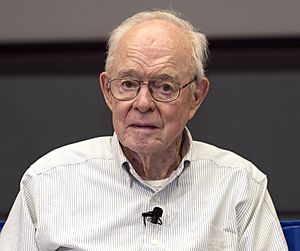Eugene Parker facts for kids
Quick facts for kids
Eugene Parker
|
|
|---|---|

Parker in 2018 at the launch of the solar probe that bears his name
|
|
| Born |
Eugene Newman Parker
June 10, 1927 Houghton, Michigan, U.S.
|
| Died | March 15, 2022 (aged 94) Chicago, Illinois, U.S.
|
| Nationality | American |
| Alma mater | Michigan State University (BS) Caltech (PhD) |
| Known for | Sweet–Parker model Solar wind Parker spiral |
| Awards | Arctowski Medal (1969) George Ellery Hale Prize (1978) Chapman Medal (1979) National Medal of Science (1989) William Bowie Medal (1990) James Clerk Maxwell Prize (2003) Kyoto Prize (2003) Crafoord Prize (2020) |
| Scientific career | |
| Fields | Solar physics, plasma physics |
| Institutions | University of Chicago |
| Thesis | The interstellar dust and gas structures (1951) |
| Doctoral advisor | Howard P. Robertson |
| Doctoral students | Arnab Rai Choudhuri |
Eugene Newman Parker (born June 10, 1927 – died March 15, 2022) was an amazing American scientist. He studied the Sun and plasma physics, which is about super hot gases found in space. In the 1950s, he came up with big ideas that changed how we understand space. He said there was something called the solar wind, a constant flow of tiny particles from the Sun. He also predicted the spiral shape of the Sun's magnetic field far out in space, called the Parker spiral. Later, spacecraft like Mariner 2 proved his ideas were correct!
In 1987, Parker also suggested that tiny explosions, called nanoflares, might be heating the Sun's outer atmosphere. This was a leading idea to solve a big mystery about the Sun. Parker earned his PhD from Caltech. He spent most of his career at the University of Chicago. In 2017, NASA honored him by naming a spacecraft after him, the Parker Solar Probe. This was the first time NASA named a spacecraft after a living person!
About Eugene Parker
Eugene Parker was born in Houghton, Michigan, on June 10, 1927. He earned his first degree in physics from Michigan State University in 1948. Then, he received his PhD from Caltech in 1951. After working at the University of Utah for four years, he joined the University of Chicago in 1955. He stayed there for the rest of his career. He worked in different departments, including physics and astronomy. In 1967, he was chosen to be a member of the National Academy of Sciences, which is a very high honor for scientists in the U.S.
Parker's Big Ideas
In the mid-1950s, Parker developed his famous theory about the solar wind. He said that the Sun constantly blows out a stream of fast-moving particles. He also predicted the Parker spiral, which is how the Sun's magnetic field twists into a spiral shape as it extends into space.
At first, many scientists didn't believe his ideas. When he sent his research to a science journal, two reviewers said it should not be published. But the editor, Subrahmanyan Chandrasekhar, decided to publish it anyway. Just a few years later, satellites like the 1962 Mariner 2 mission flew into space and proved that Parker's predictions were absolutely right!
Parker's work helped us understand many things. It explained the Sun's outer atmosphere, called the solar corona, and how the solar wind works. It also helped us understand the magnetic fields of both Earth and the Sun. In 1987, he suggested that the Sun's corona might be heated by countless tiny "nanoflares." These are like miniature solar flares that happen all over the Sun's surface. This idea became a leading explanation for how the corona gets so hot.
His Family Life
Eugene Parker was married to his wife, Niesje, for 67 years. They had two children together. He passed away in Chicago on March 15, 2022, when he was 94 years old.
Awards and Honors
Eugene Parker received many important awards for his groundbreaking work. Here are some of them:
- 1969: Arctowski Medal from the National Academy of Sciences
- 1978: George Ellery Hale Prize, the first time this prize was given
- 1989: National Medal of Science, one of the highest science awards in the U.S.
- 1990: William Bowie Medal
- 1992: Gold Medal of the Royal Astronomical Society
- 2003: Kyoto Prize, a major international award
- 2003: James Clerk Maxwell Prize for his work in plasma astrophysics, including predicting the solar wind
- 2017: NASA renamed its Solar Probe Plus spacecraft to Parker Solar Probe in his honor. This was a very special moment because it was the first time a space mission was named after a living person. Parker was there to see its launch on August 12, 2018.
- 2020: Crafoord Prize in Astronomy
See also
 In Spanish: Eugene Parker para niños
In Spanish: Eugene Parker para niños

